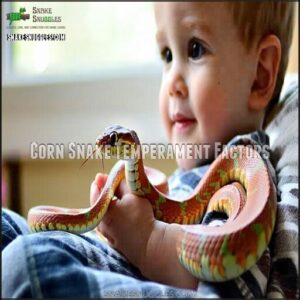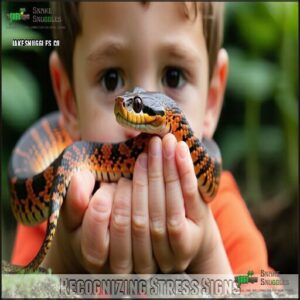This site is supported by our readers. We may earn a commission, at no cost to you, if you purchase through links.

They’re non-venomous, rarely bite, and pretty easy to handle, though young kids should always have adult supervision while interacting with them.
These snakes don’t need much upkeep, and since they don’t have fur, they’re great for allergy-sensitive households.
That said, it’s important to teach kids how to hold them gently—nobody likes being squeezed!
With proper care and attention, corn snakes can be a fascinating and safe pet that fits right in with family life.
Curious about care tips? Keep reading!
Table Of Contents
- Key Takeaways
- Corn Snake Safety Around Kids
- Kid Friendly Snake Options
- Family Pet Considerations
- Corn Snake Temperament Factors
- Creating Safe Environment
- Handling Corn Snakes Safely
- Health Risks and Precautions
- Choosing Right Pet Snake
- Frequently Asked Questions (FAQs)
- Are corn snakes safe around children?
- What is the most kid friendly snake?
- Are corn snakes good family pets?
- Can corn snakes be affectionate?
- Do corn snakes recognize individual family members?
- Can corn snakes respond to a child’s voice?
- What is the ideal time for child interaction?
- How do corn snakes react to loud environments?
- Can children assist with snake enclosure cleaning?
- Conclusion
Key Takeaways
- Corn snakes are non-venomous, rarely bite, and have a calm temperament, making them safe and easy for kids to handle under adult supervision.
- Good hygiene is essential since corn snakes can carry Salmonella; always wash hands after handling and avoid face contact during interaction.
- They’re low-maintenance pets with basic care needs like proper enclosures, temperature control, and gentle handling to prevent stress.
- With regular handling and care, corn snakes become docile, making them a great long-term pet for families.
Corn Snake Safety Around Kids
In the case of kids and corn snakes, safety is all about smart handling and good hygiene.
With the right precautions, you can enjoy the fun of owning one without worrying about unnecessary risks.
Disease Transmission Risks
When keeping corn snakes with children, be cautious about disease transmission. Reptiles like corn snakes can carry Salmonella, posing risks if hygiene is overlooked.
Wash hands after handling snakes; simple hygiene keeps your family safe and prevents the risks of disease transmission.
- Wash hands after snake handling to prevent infections.
- Avoid touching your face while handling the snake.
- Clean enclosures frequently to prevent bacteria buildup.
- Look for signs of parasite concerns, like itching or mites.
- Teach kids proper hygiene for safe interaction.
Handling Safety Precautions
Always offer gentle support when holding a corn snake. Keep a firm but relaxed grip and avoid quick movements.
Teach kids snake handling safety and supervise children closely to prevent accidents.
Never handle a snake right after feeding or during shedding, as this can cause stress. Knowing a snake’s behavior helps, so watch for signs of stress.
Wash hands before and after handling to reduce health risks like Salmonella.
Supervision Requirements
Parental involvement is key when children handle corn snakes.
Constant oversight guarantees snake safety and bite prevention, especially for younger kids.
Teach age-appropriate handling education, like being gentle and supporting the snake’s body.
Hygiene practices, like washing hands afterward, are a must, and with proper pet supervision, kids can safely enjoy snake handling and develop respect for these fascinating creatures, learning about snake safety and the importance of gentle handling.
Kid Friendly Snake Options
You’ve got plenty of options if you’re looking for a kid-friendly snake, but corn snakes are a top choice.
They’re calm, easy to handle, and perfect for families new to reptiles.
Comparison to Other Snake Breeds
Corn snakes stand out among snake breeds for their calm temperament, ideal for children.
Compared to Ball Pythons, which are docile but shy, and King Snakes, known for bold behaviors, corn snakes balance ease of care with friendliness.
Garter Snakes are smaller but more active, while Rosy Boas and Milk Snakes share similar calm natures, making these snakes great options for families.
Temperament Considerations
When thinking about snake temperament for children, corn snakes are a top pick.
Their calm demeanor and docile nature keep handling simple and enjoyable. Frequent handling helps build trust and highlight their unique personalities.
Here’s why they shine:
- They rarely show aggression.
- Their slow movements are beginner-friendly.
- Personalities vary, but they’re usually mellow over time.
Safe, friendly, and approachable!
Handling Ease
Corn snakes’ gentle movements and calm demeanor make them beginner-friendly and perfect for children learning snake handling.
Corn snakes are calm, easygoing pets, making them ideal for children and families new to the world of reptiles.
Their docile nature means they’re tolerant of curious, small hands, reducing the risk of stress or a snake bite.
With regular handling, they often relax further, creating a bond that’s both safe and rewarding. They truly are the "easygoing pets" of the snake world, making them an excellent choice for those looking for a "beginner-friendly" pet.
Family Pet Considerations
When choosing a corn snake as a family pet, think about their space needs and how they fit into your daily routine.
They’re low-maintenance, but a long-term commitment—kind of like owning a scaly roommate who doesn’t pay rent.
Space and Housing Needs
A proper enclosure is key to a happy, healthy corn snake. Give them space to stretch out and explore! Look for a terrarium at least 60x45x45 cm with a temperature gradient and 40-60% humidity.
- Use aspen or cypress for substrate—easy to clean and comfy for them.
- Add hiding spots for a secure retreat.
- Include enrichment items like branches or plants for climbing fun!
Family Lifestyle Factors
A corn snake’s easygoing temperament fits well into most family lifestyles, but consider your family schedules and travel habits.
Snakes don’t snuggle, but they also don’t mind low-noise levels or missed attention during busy weeks.
Kids and snakes can coexist safely if allergic reactions aren’t a concern and everyone’s ready for a pet that’s unique yet simple to care for.
These snakes are known as beginner friendly due to their calm nature.
Long-term Commitment
Owning a corn snake isn’t a quick commitment—it’s a 10-15 year promise.
Be prepared for:
- Financial Burden: From enclosures to vet care, costs add up.
- Lifespan Expectations: Long-term care requires dedication.
- Rehoming Options: If life changes, plan responsibly.
Snake long-term commitment involves serious responsibility; this isn’t a decision to slither into lightly!
Corn Snake Temperament Factors
Your corn snake’s temperament depends on a mix of its environment, genetics, and age. By understanding these factors, you can help it stay calm and comfortable around your kids.
Environmental Influences
A calm, happy snake starts with its home.
Enclosure design impacts temperament, so include hiding spots and enrichment items they’ll love.
Maintain temperature gradients (85°F warm, 75°F cool) and humidity levels at 40-60%.
Substrate choice matters too—like aspen shavings for comfort.
A well-cared-for environment boosts snake safety, reduces stress, and guarantees handling around children is safe and enjoyable.
Genetic Factors
Inherited docility plays a big role in shaping a corn snake’s gentle snake temperament.
Breeders intentionally select for personality traits, ensuring a nonaggressive, docile snake ideal for children.
Color morphs don’t just add flair—they can hint at unique quirks too.
Genetic health is key, as ethical breeding aims to minimize issues while enhancing snake temperament for a calm, kid-friendly pet, with docile traits.
Age and Maturity
As snakes mature, their temperament shifts.
Juvenile corn snakes often seem feisty and squirmy, but this mellows with age into the adult docility they’re known for.
Patience during their younger years builds trust, making handling changes easier.
These lifespan behavior shifts highlight how maturity impacts snake and child interaction risks, creating safer, calmer moments for kids and snakes alike.
Creating Safe Environment
You’ve got to create a safe space where your corn snake can thrive and interact comfortably with your child.
Focus on the right enclosure size, stable temperatures, and a few cozy hiding spots to keep your scaly friend happy and healthy.
Proper Enclosure Size
For hatchlings, a 20-gallon tank works well.
As your corn snake matures, upgrade to a 40-gallon terrarium to match its adult size.
Focus on horizontal space over vertical, since corn snakes love to slither, not climb.
A suitable starter habitat is essential for young corn snakes.
Use sturdy enclosure materials and add space enrichment like hiding spots and logs.
A properly sized enclosure keeps your snake happy and healthy!
Temperature and Humidity Control
Keeping the right temperature and humidity levels for your corn snake is like creating a personalized spa.
Here’s what to do:
- Maintain a temperature gradient: 75°F (cool) to 85°F (warm).
- Use heating methods: Overhead lamps or heat mats work well.
- Track humidity with a hygrometer: Aim for 40-60%.
- Consider using specialized reptile products to maintain ideal conditions.
- Prevent shedding issues: Mist lightly if humidity drops.
Hiding Spots and Enrichment
A happy corn snake needs more than a simple tank—it thrives with enrichment benefits like hiding spots and climbing structures.
Use naturalistic setups with varied hiding variety to mimic their wild habitat. Add stimulation methods like logs or faux plants.
Proper snake hides are essential for reducing stress and promoting healthy behaviors.
These enrichments boost your snake’s temperament and also engage curious children, teaching them care and responsibility.
Handling Corn Snakes Safely
When you handle a corn snake, it’s important to be gentle while supporting its body.
Avoid sudden movements or squeezing, and you’ll both feel more at ease during the interaction, this will help you to be gentle.
Gentle Handling Techniques
A big part of keeping your corn snake safe and happy is how you handle it.
Start with a gradual introduction to build trust and confidence. Always provide proper support with both hands and avoid squeezing. Supervised handling guarantees safety for kids and snakes alike.
For additional safety, some handlers choose to use specialized handling equipment.
- Support gently: One hand near the head, one near the tail.
- Limit handling: Once daily, max.
- Stay calm: Avoid sudden movements.
Avoiding Stress Triggers
After gentle handling, focus on avoiding stress triggers to keep your snake calm.
Skip handling after feeding or during shedding—it’s their quiet time.
Confirm enclosure security to prevent escapes, which can cause stress.
Handle your new snake lightly and limit frequency at first.
Always support their body to avoid mishaps, ensuring children learn proper snake handling.
| Trigger | Stress Factor | What to Do | Impact on Snake |
|---|---|---|---|
| Post-feeding | Stomach discomfort | Avoid handling after meals | Prevents regurgitation |
| Shedding | Skin sensitivity | Don’t handle during shedding | Promotes calmness |
| Over-handling | Feelings of overwhelm | Limit handling frequency | Builds trust over time |
| Escape attempts | Anxiety from insecurity | Secure enclosure properly | Provides a safe habitat |
To ensure the well-being of your snake, it’s crucial to understand and manage stress factors.
By following these guidelines and being mindful of your snake’s needs, you can create a harmonious and healthy environment.
Recognizing Stress Signs
Spotting stress in corn snakes helps guarantee safe handling, especially with children.
Watch for these signs:
- Defensive postures like coiled necks signal discomfort.
- Erratic movements show agitation or fear.
- Refusal to eat or excessive hiding reflect prolonged stress.
- Rapid tongue flicking can mean unease.
Recognizing these clues helps you respect your snake’s temperament and create a calmer environment.
Health Risks and Precautions
Keeping your family safe around a corn snake is simple if you know the risks and take a few basic precautions.
From washing hands to watching for signs of illness, it’s all about staying informed and being consistent.
Salmonella Transmission
Corn snakes can carry Salmonella, so good hygiene practices are a must.
Always wash hands after handling your snake or cleaning its enclosure.
The CDC warns that vulnerable groups like young children are at higher risk of infection.
Reptiles account for a relatively small percentage of cases, with the majority from food.
Prevent disease transmission by keeping reptiles out of food areas and teaching kids simple prevention strategies to reduce risk effectively, which is crucial for public health.
Feeding Challenges
Feeding challenges can pop up if prey size isn’t just right.
Offering frozen mice that are too big may lead to refusal to eat or even regurgitation. Stick to properly-sized prey for smooth snake feeding.
Feeding frequency matters too—juveniles eat more often than adults.
Always use a trusted food source to keep your snake healthy and happy!
Common Health Issues
Watch for health concerns like respiratory infections, scale rot, or mouth rot, which can sneak up if the enclosure isn’t clean.
Parasites may cause itching, weight loss, or fatigue. Overfeeding risks obesity, so stick to a proper schedule.
Salmonella is another concern—wash your hands thoroughly every time. Regular monitoring prevents snake diseases and keeps your scaly friend happy and healthy!
Choosing Right Pet Snake
Picking the right pet snake for your family means thinking about what works best for everyone, including the snake.
Corn snakes are a great choice because they’re easy to care for, safe with kids, and make a perfect long-term companion.
Research and Planning
Before bringing home a corn snake, do some initial research.
Look into snake temperament, costs, and legal considerations. Make sure your family is ready for the commitment.
Talk to reputable snake breeders and ask questions. Consider how the snake’s needs align with your routine.
Planning prevents surprises and guarantees your new pet fits seamlessly into your home, which is a key part of making sure you are ready for the commitment and that planning is thorough.
Considering Family Needs
When picking a corn snake as a family pet, think about your family’s lifestyle.
Does your schedule leave time for care? Consider your child’s age, pet experience, and even family allergies.
Corn snakes need simple upkeep, but their temperament is ideal for kids. They’re low-maintenance, yet require a small time commitment to stay happy and healthy!
It’s also important to take into account snake breed characteristics when making your decision.
Preparing for Long-term Care
Thinking about owning a corn snake means planning ahead for the long haul. Their life expectancy can range from 10-15 years, so snake commitment is key.
Be ready for ongoing care and maintenance as well as veterinary support. Future relocations? Consider the snake’s habitat needs.
Success stories come with responsible ownership, health monitoring, and steady financial commitment.
- **Plan for lifespan (10-15 years).
- **Schedule regular vet checkups.
- **Budget for food, care, and supplies.
- **Prepare for careful habitat moves.
- **Consistent maintenance guarantees health.
Frequently Asked Questions (FAQs)
Are corn snakes safe around children?
Corn snakes are generally safe around kids due to their calm demeanor and non-venomous nature.
However, supervise interactions, teach gentle handling, and make certain proper hygiene to minimize Salmonella risks.
Safety and consistency make a perfect match!
What is the most kid friendly snake?
If you want a kid-friendly snake, consider a ball python or a corn snake.
They’re both calm, easy to handle, and low-maintenance.
Their chill personalities and manageable size make them great for families.
Are corn snakes good family pets?
Did you know corn snakes can live up to 15 years?
That’s a big commitment, but their calm temperament, low upkeep, and family-friendly demeanor make them one of the best choices for a pet snake.
Can corn snakes be affectionate?
Corn snakes aren’t exactly affectionate, but they’re calm, curious, and can develop trust with regular handling.
They may even seem to enjoy being out of their enclosure, but it’s more about comfort than love.
Do corn snakes recognize individual family members?
Studies suggest reptiles, including corn snakes, have basic recognition abilities tied to scent and routine.
While they don’t recognize individual family members like a dog might, they’ll associate familiar handling and feeding patterns with certain people, which can be considered a form of recognition.
Can corn snakes respond to a child’s voice?
They don’t respond to voices like a dog does, but they might sense vibrations from sounds, including your child’s voice.
While they won’t recognize it, these vibrations could sometimes grab their attention.
What is the ideal time for child interaction?
Think of interaction timing like planting seeds; patience matters.
Late afternoons are ideal since corn snakes are typically more active then.
Avoid mornings or feeding days to keep interactions stress-free and enjoyable for everyone.
How do corn snakes react to loud environments?
Corn snakes typically handle loud environments well but can become stressed if the noise is constant or excessive.
Watch for signs like hiding, erratic behavior, or refusal to eat to gauge their comfort.
Can children assist with snake enclosure cleaning?
Kids can help with enclosure cleaning, but stick to simple tasks like changing water or wiping surfaces.
Avoid letting them handle the snake or deep clean, as fragile snakes and germs require careful adult supervision.
Conclusion
In the case of finding a pet that’s cooler than your favorite retro cassette, corn snakes shine with their calm and friendly temperament—especially around children.
They’re safe, easy to handle, and a great fit for families willing to supervise interactions and teach gentle handling.
Allergy-sensitive households will also love their fur-free appeal.
With a bit of effort to create the right environment, your corn snake can become a fascinating, low-maintenance companion that the whole family enjoys.
- https://nationalzoo.si.edu/animals/corn-snake
- https://talis-us.com/blogs/news/why-isnt-my-corn-snake-eating
- https://www.chameleonforums.com/threads/corn-snake-or-bearded-dragon.27724/
- https://reptifiles.com/reptiles-and-salmonella/
- https://www.gov.uk/government/news/reptiles-pose-a-risk-of-salmonella-infection


















